Punjab State Board PSEB 9th Class Science Important Questions Chapter 12 Sound Important Questions and Answers.
PSEB 9th Class Science Important Questions Chapter 12 Sound
Long Answer Type Questions:
Question 1.
(A) Name two different types of waves.
(B) Give an experiment to explain the formation of transverse waves.
(C) Define transverse waves.
(D) What should be the conditions for the production of transverse waves?
(E) Give examples of transverse waves.
(F) Define crest and trough.
Answer:
(A) Types of Waves: Waves are classified according to the direction of vibration of particles of the medium. It can be either in the direction parallel to the direction of propagation of wave or in a direction perpendicular to the direction of propagation. In this way waves are of two types:
- Transverse waves
- Longitudinal waves.
(B) Formation of Transverse waves. To understand the formation of transverse waves attach one end of a long string to the hook fixed in the wall as shown in the figure, Hold the other end of the string in your hand. The coloured threads of length 10 cm each with the string at equal distance as shown in the figure.
image
Now give jerk to the slinky. An upward maund or hump is formed in the string which travels along the string towards the fixed end. Such sudden disturbance that lasts for short duration is called pulse i.e. the particles of string move along with the disturbance in the perpendicular direction.

As shown in fig. (c) if we continuously give up and down jerks to the free end of the string a number of waves begin to travel along the string forming a wave train. Each part of the string vibrates up and down while the waves travel along the string. So the waves in the string are transverse in nature.
The points (c, c, c …………… ) of maximum displacement in the upward direction are called crests and the points (T, T, T…………) of maximum displacement in the downward direction are called troughs.
(C) Transverse Wave: These are the waves in which particles of the medium vibrate (up and down) in a direction perpendicular to the direction of propagation of wave.
(D) Conditions necessary for formation of transverse waves:
- The medium should have property of inertia.
- The medium should have property of elasticity so that the particles can come back to their original positions after being disturbed.
- The medium should have minimum frictional force between its particles so that the particles may keep vibrating for a long.
- Vibrations of plucked stretched string of a violin.
(E) Examples of Transverse Waves.
- In loose string or spring: If a string is held in hand and the other end is tied to a fixed support and it is continuously moved up and down then transverse waves are produced.
- Wave on the surface of still water: If a pebble is dropped gently on the surface of still water of a pond then ripples are produced on the water surface.
- A cork floating on the surface of water would then begin to vibrate up and down then transverse waves are produced. The cork is not displaced with the waves but keeps tossing up and down,
(F) Crests and Troughs:
- Crests: In transverse waves, the particles of the medium which have maximum displacement in the upward positive direction along Y-axis are called crests.
- Troughs: In transverse waves, the particles of the medium which have maximum displacement in the downward negative direction along Y-axis are called troughs.
![]()
Question 2.
(A) Define longitudinal wave.
(B) Arrange an experiment to demonstrate the formation of longitudinal wave.
(C) In reference to longitudinal wave, define compressions and rarefactions.
Answer:
(A) Longitudinal wave. Those waves in which the particles of the medium vibrate about their mean position in the direction of propagation of disturbance are called longitudinal waves and the wave motion is called the longitudinal wave motion. Sound in air gets propagated in the form of longitudinal wave motion consisting of regions of compressions and rarefactions.
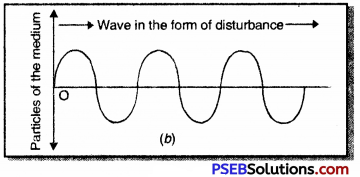
(B) Experiment: Consider, a tuning fork struck gently with a rubber pad so that its prong begins to vibrate [Fig. (a)]. As prong moves towards right, it compresses the layer of air in contact with it. As air has elasticity, the compressed air tends to relieve itself of its strain and moves towards the right to compress the next layer and so on.
Thus, a wave of compression moves towards the right. At the point of compression, there is an increase of pressure and is shown in form of crest C. At the point of rarefaction of concentration of particles is least and has been shown as trough R. When the prong moves towards left, a region of reduced pressure or rarefaction is produced towards right [Fig. (b)].
Examples:
- Hearing in man,
- Vibrating tuning fork,
- Beating diaphragm of drum.
(C) Compressions and Rarefactions:
Compression: The region of high pressure in the longitudinal wave so that the particles of the medium are closer to each other than the normal distance between them. The higher the pressure, the higher is the number of particles per unit volume i.e. higher is the density, is called compression. In fig it is denoted by ‘c’.
Rarefaction: The region of low pressure in the longitudinal wave so that the particles of the medium are far away from each other than the normal distance between them, is called Rarefaction. In fig it is denoted by ‘R’.
Question 3.
Establish the relation between wave velocity, wavelength and frequency of a wave.
Solution:
Suppose
υ = Wave velocity
ν = Frequency of the wave (i.e. frequency of vibrating particles of the medium)
λ = Wavelength of wave.
T = Time period of a vibrating particle (i.e. time taken by particle of the medium to complete 1 vibration)
Distance travelled by the wave during T seconds = λ
∴ Distance covered by the wave in unit time (1 s) = \(\frac{\lambda}{\mathrm{T}}\)
But distance covered in unit time is wave velocity
∴ υ = \(\frac{\lambda}{\mathrm{T}}\)
or υ = \(\frac {1}{T}\) × λ
∴ υ = ν × λ [∵ \(\frac {1}{T}\) = ν]
i. e. Wave velocity = Frequency × Wavelength
This relation is true both for longitudinal and transverse waves.
Question 4.
Distinguish between sound waves and light waves.
Answer:
Difference between sound waves and light waves
| Sound Waves | Light Waves |
| 1. Sound waves are mechanical waves. | Light waves are electromagnetic waves. |
| 2. Sound waves are longitudinal waves in which the direction of vibration of particles of the medium is same as that of propagation of wave. | Light waves are transverse waves in which the vibration of the particles of the medium is in a direction perpendicular to the direction of propagation of wave. |
| 3. Sound waves can not travel through vacuum. These require some material medium. | Light waves can travel through vacuum. |
| 4. Speed of sound waves in air is 340 m s-1. | Speed of light waves in air is very large. It is 3 × 108 m s-1. |
| 5. Sound waves are produced due to vibrations of particles of related medium. | Light waves depend upon the change in electromagnetic fields. |
| 6. Sound waves have low frequency and large wavelength. | Light waves have high frequency and small wavelength. |
| 7. Sound waves cannot be polarised. | Light waves can be polarised. |
| 8. Sound waves produce effect on our ears. | Light waves produce effect on our eyes. |
| 9. The velocity of sound waves is independent of the wavelength of wave. | The velocity of lightwave depends upon the wavelength of the wave. |
![]()
Question 5.
Explain the classification of sound waves on the basis of frequency range.
Answer:
1. Audible waves: Those sound waves to which human ears can respond (i.e. those sounds waves which can be heard by human beings). In human beings the audible range is from 20 Hz to 20,000 Hz. As the human being advances in age his ears become less sensitive to sounds of high frequencies. These waves are produced by vibrations in air column, tuning fork and violin.
2. Ultrasonic waves: The sound waves having frequency above 20 KHz (i.e. 20,000 Hz) are called ultrasonic waves or ultrasonics. Insects of some species can hear such sound waves. Bats, dolphins, etc. produce such sound waves.
3. Infrasonic waves: Those sound waves which have frequency less than 20 Hz are called infrasonic waves or infrasonics. Whale and elephants produce infrasonic waves. These waves are produced before the main high frequency waves of earthquake occur on hearing these waves the animals become terrorised and become impatient.
Question 6.
What are the laws of reflection of sound? How will you prove these laws experimentally?
Answer:
Like light, sound also obeys the laws of reflection these are:
1. The angle made by incident sound and reflected sound with the normal to the reflecting surface at the point of incidence are always equal.
i.e. \(\angle i=\angle r\)
2. The incident sound, the normal at the point of incidence and the reflected sound all lie in the same plane.
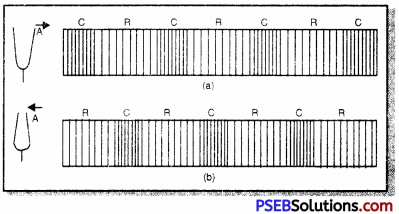
Experimental Verification:
Take two cardboard tubes A and B about 1 m long and 5 cm in diameter. Mount the tubes as shown in figure facing metal plate as shown in fig. Place a watch at the mouth of the tube A and try to hear the sound by applying ear close to the end of the tube B.
Place a screen S made of cardboard or of some other absorbing material in between the two tubes to prevent sound from reaching our ear directly. It will be observed that the sound is maximum when angles made by tubes A and B with normal are equal i.e., \(\angle i=\angle r\)
Question 7.
List the three characteristics of sound waves. State the factors on which each of these characteristics depends.
Answer:
Characteristics of sound: The three characteristics of sound are
- Loudness
- Pitch and
- Quality or timbre.
1. Loudness: It is the response differently i.e., one sound louder than the other of ear to the intensity of sound. It distinguishes between a loud sound and soft (low) sound. Even two sounds of equal intensity, may hear. Loudness depends on two main factors.
Factors on which sound depends:
(a) Intensity of sound
(b) Sensitivity of ear.
Graphs given below show the wave shape of a loud sound and a soft sound having the same frequency.
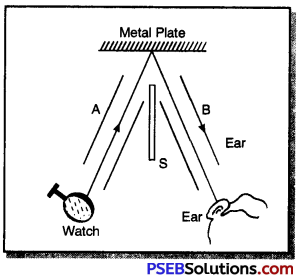
2. Pitch: Pitch is the sensation which helps a listener to distinguish between a high and a low note. Pitch depends on frequency. The faster the vibration of the source of sound, the higher is the frequency and higher is the pitch,
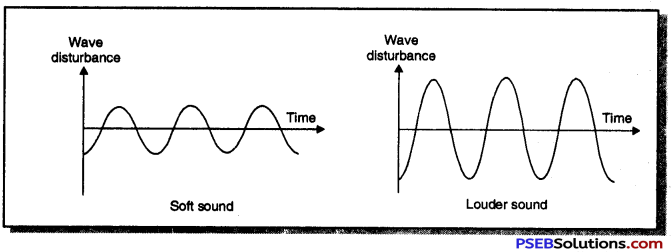
The voice of a child or a lady is shriller than that of a man i.e., the pitch of a lady’s sound is higher than that of a man. The mosquito’s sound is of high frequency and hence high pitch.
3. Quality or timbre. The quality or timber of sound is that characteristic which helps us, to distinguish one sound from another having the same pitch and loudness. It is due to the quality of sound that one can recognise the voice of friend without seeing him.
![]()
Short Answer Type Questions:
Question 1.
What is periodic motion? Give three examples.
Answer:
Periodic motion: The motion of a body that repeats itself regularly after a fixed interval of time is called periodic motion. Such type of motion is vibratory motion.
Examples of periodic motion.
- Motion of the earth around the sun.
- The motion of a swing which moves to and fro (left and right) about its mean position.
- The motion of a simple pendulum.
- The motion of the hands of a clock.
Question 2.
Define oscillatory motion. Give examples.
Answer:
Oscillatory or vibratory motion. If a body moves to and fro repeatedly about a fixed position (called mean position), its motion is said to be oscillatory or vibratory motion.
Examples of oscillatory motion:
- Motion of the pendulum of a wall clock.
- Motion of a swing.
Question 3.
Differentiate between transverse waves and longitudinal waves.
Answer:
Differences between transverse and longitudinal waves:
| Transverse waves | Longitudinal waves. |
| 1. In transverse waves, the particles of the medium vibrate perpendicular to the direction of wave motion. | In longitudinal waves, the particles of the medium vibrate along the direction of wave motion. |
| 2. These waves travel in the form of alternate crest and troughs. | These waves travel in the form of alternate compressions and rarefactions. |
| 3. These waves can be transmitted through solids or liquid surfaces. | These waves can be transmitted through all the three media, viz (i) solids, (ii) liquids and (iii) gases. |
| 4. They do not cause pressure changes in the medium through which they pass. Example. Waves formed over water surface. | They cause changes in the pressure of the different parts of the medium through which they pass. Example. Sound waves in air, |
Question 4.
How is sound propagated? Can it be propagated through vacuum? out of solid, liquid and gas in which medium speed of sound is maximum and in which it is least?
Answer:
The propagation of sound is in the form of transverse waves therefore sound waves consist of compressions and rarefactions. The source of sound is always in vibrating state. The sound emitted by a vibrating source can always propagates through a medium.
Sound can not travel through vacuum. Transverse waves can travel through all the three mediums solid, liquid and gas. This happens due to elasticity of the medium. Solids are more elastic than liquids and gases. It has been proved experimentally that the speed of sound is maximum in solids the least in gases.
![]()
Question 5.
What are applications of ultrasound?
Answer:
Applications of ultrasound:
- Glaton whistle. It is used by hunters. When hunter and hound (hunting dog) get separated an hunter wants to call back dog to help him catch the prey, he blows the Glaton whistle which produces only ultrasonic waves.
- These waves can be heard by dog but not by other animals and birds of the forest.
- Bats judge the distance of prey or the coming obstacle by sending these waves. By observing the time taken by waves to travel back, they can find the distance of the obstacle/ prey.
- Ultrasound waves are used to find the depth of the sea.
- Ultrasonic waves are used by doctors for scanning different parts of the body.
- These waves are used by dentists to compress the silver filled in the cavity of teeth.
- These are used to clean parts located in hard-to-reach places. Objects are cleaned in cleaning solution and ultrasonics are passed in the solution.
- Particles of dust, grease get detached due to high-frequency vibrations and get into cleaning solution.
Question 6.
Define the terms wave and wave motion.
Answer:
Wave and wave motion. A wave is a pattern of disturbance which travels through a medium due to repeated vibrations of the particles of the medium, the disturbance being handed over from one particle to the next. The motion of the disturbance is called wave motion.
Question 7.
Distinguish between a wave pulse and a periodic wave.
Answer:
| Pulse | Periodic wave |
| 1. A pulse is a wave produced by a sudden disturbance of short duration. | A periodic wave produced by continuous and regular vibrations of the particles of the medium. |
| 2. Due to pulse, the medium oscillates for a short time and then returns to its undisturbed position. | Due to periodic wave, medium vibrates for a long time after being disturbed. |
| 3. It is not repetitive. | It repeats itself after a fixed interval. |
| 4. It is formed in a small portion of the medium. | It spreads over the entire length of the medium. |
Question 8.
What are mechanical or elastic waves? Give examples.
Answer:
Mechanical waves: The waves which require a material medium for their propagation are called mechanical waves. They are also called elastic waves because their propagation depends on the elastic properties of the medium.
Examples of mechanical waves:
- Sound waves in air.
- Waves over water surface
- Waves produced during an earthquake. These are known as seismic waves.
![]()
Question 9.
State two factors on which the speed of sound depends.
Answer:
The speed of sound through a medium depends on following two factors:
- Nature of the medium.
- Temperature of the medium.
Question 10.
Explain in brief the dependence of speed of sound on nature of material medium and temperature.
Answer:
Speed of sound in different media. Sound travels fastest through solids and slowest through gases. This is because elasticity of solids is much greater than that of liquids which in turn, is greater than that of gases.
Effect of Temperature. The speed of sound increases with the increase in temperature of the medium through which sound travels.
Question 11.
Define the terms time period and frequency of an oscillating body. Give their units and write the relation between them.
Answer:
Time period: The time taken by an oscillating body to complete one oscillation is called its time period. It is denoted by T. Its SI unit is second(s).
Frequency: The number of oscillations or vibrations completed by an oscillating body in one second is called its frequency. It is denoted by ν (Greek letter nu).
SI unit of frequency = per second (s-1) = cycles per second (cps)
= hertz (Hz).
Relation between time period and frequency.
Let T = time period of an oscillating body. Then,
number of oscillations completed in “T second = 1
number of oscillations completed in 1 second = \(\frac {1}{T}\)
But number of oscillations completed in 1 second = frequency (ν)
∴ ν = \(\frac {1}{T}\)
Hence frequency is equal to the reciprocal of time period.
Question 12.
Give two practical applications of reflection of sound waves.
Answer:
Two practical applications of reflection of sound waves:
1. Reflecting boards. In large halls or auditorium large wooden boards are fixed behind the speaker in the form of a concave cylinder. The sound waves on striking the reflecting boards get reflected parallel to the principal axis reaches everyone in the auditorium so that everyone can hear clearly. The working of reflective board is based on reflection.

2. Ear trumpet. The sound energy received by the wide end of the trumpet is reflected into much smaller area thereby increasing the intensity of sound. Hence, a person who is hard of heamg, can hear the sound distinctly.
![]()
Question 13.
Distinguish between the terms music and noise.
Answer:
- Music: The sound which has a pleasing sensation to the ears is called music. It is produced by regular and periodic vibrations, without any sudden change in loudness.
- Example: The sound produced by plucking the string of a sitar, sound from a tabla, etc.
- Noise: The sound which has a displeasing on the ears is called noise. It is produced by vibrations at irregular intervals and with sudden change in loudness.
- Example: The sound produced by an explosion.
Question 14.
How can bats ascertain distances, directions, nature and size of the obstacles without eyes?
Answer:
Bats can produce and receive ultrasonic waves. During flight, a bat emits ultrasonic waves. The bat receives back these waves after being reflected by the obstacle in its path. From the time interval between transmission and reception of ultrasonic waves, the bat gets information about the distance, nature of obstacle and its direction of location. Hence bats can move about freely even in total darkness.
Question 15.
It is observed that some animals get disturbed before earthquake. How?
Answer:
Earthquakes produce low-frequency infrasound before the mainshock waves begin. These infrasonic waves are out of our audible range. But animals are able to detect these waves and hence some animals get disturbed before earthquakes.
Important Formulae:
- Wave Velocity (υ) = ν × λ
- Frequency (ν) = \(\frac {1}{T}\)
- Wave length (λ) = v × T
- Total Distance = Velocity × Time
Numerical Problems (Solved):
Question 1.
What will be the frequency of Mohan’s heart when it beats 75 times in 1 minute?
Solution:
Time taken for 75 heart beats = 1 min
= 60 s
and time taken for 1 heartbeat = \(\frac {60}{75}\)
∴ Time period (T) = 0.80 s
We know, frequency (ν) = \(\frac{\text { 1 }}{\text { Time Period(T) }}\)
= \(\frac {1}{0.80}\)
= 1.25 Hertz (Hz)
![]()
Question 2.
A boat strikes waves of ocean having crest 100 m away. The wave velocity of crest is 20 m s-1. What is the frequency of waves striking the boat?
Solution:
Wave length (λ) = 100 m
Wave velocity (υ) = 20 m/s
Frequency (ν) = ?
We know, υ = ν × λ
20 = v × 100
or ν = \(\frac {20}{100}\)
= 0.2 Hertz (Hz)
Question 3.
A source of wave produces 40 crests in 0.4 s. Find the frequency of wave.
Solution:
A wave cycle consists of one crest and one trough.
Since the given source produces 40 crests, it produces 40 wave cycles in 0.4 s.
No. of wave cycles produced in 0.4 s = 40
No. of wave cycles produced in 1 s = \(\frac {40}{4}\)
= 100
∴ Frequency of wave = 100 Hz
Question 4.
A source produces a sound of wavelength. 1.7 x 10-2 m. If its velocity is 343.4 m s -1, then find frequency of sound,
Solution:
Velocity, υ = 343.4 ms-1
Wave length, λ = 1.7 × 10-2 m;
Frequency, ν = ?
We know, υ = ν × λ
ν = \(\frac {υ}{λ}\)
= \(\frac{343.4}{1.7 \times 10^{-2}}\)
∴ Frequency, ν = 2.02 × 104 Hz
Question 5.
What will be the frequency of the wave, if its time period is 0.05 s?
Solution:
Here Time Period T = 0.05 s
Frequency, ν = ?
But Frequency, ν = \(\frac{\text { 1 }}{\text { Time Period(T) }}\)
= \(\frac {1}{0.05}\)
= \(\frac {100}{5}\)
= 20Hz
Question 6.
A distance displacement of a periodic wave is shown in a graph, if velocity of the wave is 320 m s-1 , then find (a) wavelength (b) frequency.
Solution:
(a) Wavelength = Distance between two consecutive crests
= 50 – 10
= 40 cm
= \(\frac {40}{100}\)m/s
= 0.4 m
(b) Velocity of wave, υ = 320m/s
Wavelength, λ = 0.4 cm
Frequency, ν = ?
We know, υ = ν × λ
or ν = \(\frac {υ}{λ}\)
= \(\frac {320}{0.4}\)
Frequency, ν = 800 Hz
![]()
Question 7.
Longitudinal waves is produced on a spring. This wave travels with a velocity of 30 cm/s and its frequency is 20 Hz. What is the minimum distance between two consecutive compressions?
Solution:
Here, wave velocity, υ = 30 cm/s
= 0.30 m/s
Frequency, ν = 20 Hz
Wave length, λ = Distance between two consecutive compressions = ?
υ = ν × λ
or λ = \(\frac {υ}{ν}\)
= \(\frac {0.30}{20}\) = 0.15 m
Question 8.
A message was transmitted from boat which returned to the sender after reflection from the bottom of the sea in 0.8 s. If the velocity of sound in water is 1500 ms-1 then find the depth of sea.
Solution:
Velocity of sound, υ = 1500 ms-1
Time taken, t = 0.8 s
Distance travelled by sound = Velocity of wave × Time
Total distance travelled by sound (2d) = 1500 × 0.8 = 1200 m
∴ Depth of sea = \(\frac {1200}{2}\)
= 600 m
Question 9.
The frequency of a tuning fork is 600 Hertz. What will be its time period?
Solution:
Time period of tuning fork = \(\frac{\text { 1 }}{\text { Frequency of Tuning fork }}\)
= \(\frac {1}{400}\)
= 0.0025 s
Question 10.
A stone is dropped in a 44.1 m deep well. If the sound produced by striking of stone with the water surface is heard after 3.13 s then find the velocity of wave in air.
Solution:
Given : Depth of well(h) = 44.1 m
Acceleration due to gravity (g) = 9.8 m s-2
Time taken by stone go to the surface (t)= 313 s of water and sound to return
Suppose stone takes t1 time to reach the water surface, then from
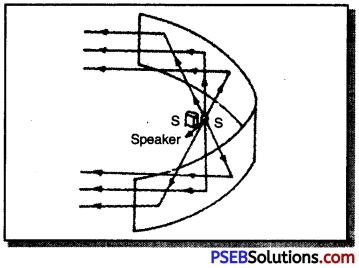
Question 11.
A man claps near a cliff and echo is heard after 5 s. If the velocity of sound is 346 m s-1, then what will be the distance between the man and the cliff?
Solution:
Velocity of sound (v) = 346 m s-1
Time taken for echo to be heard (t) = 5 s
Distance travelled by sound (S) = υ × t
= 346 m s-1 × 5 s
= 1730 m
Sound took 5 s to travel twice the distance between man and cliff
Distance between man and cliff = \(\frac {1730}{2}\)
= 865 m
![]()
Question 12.
A ship produces ultrasonic sound which is collected in 3.42 s after reflection from the surface of sea. If the velocity of ultrasonics is 1531 m s-1, then what is the distance of sea surface from sea?
Solution:
Time taken from transmission to collection of sound (t) = 3.42 s
Velocity of ultrasonics in sea water (υ) = 1531 m s-1
Distance travelled by transmitted sound= 2d where d is the depth of sea
2d = velocity of sound × time
2d = 1531 m s-1 × 3.42 s
2d = 5236 m
d = \(\frac {5236}{2}\)
= 2618 m
∴ Distance of ship from sea surface (d) = 618 m
Very Short Answer Type Questions:
Question 1.
What is sound?
Answer:
Sound: It is a kind of energy which produces in us the sensation of hearing.
Question 2.
In which medium the velocity of sound is more – Solids or Gases?
Answer:
In solids, velocity of sound is more i.e. sound travels faster in solids than in gases.
![]()
Question 3.
What frequency of sound is audible to human ear?
Answer:
Human ear can hear sound of frequency from 20 Hz to 20,000 Hz.
Question 4.
What is the nature of sound Longitudinal wave or Transverse wave?
Answer:
Longitudinal wave.
Question 5.
What should be the properties of the medium for producing sound waves?
Answer:
The medium should have the property of (i) inertia and (ii) elasticity.
Question 6.
What is the relation between frequency, wavelength and wave velocity?
Answer:
Wave velocity = Frequency × Wavelength.
Question 7.
What is the unit of frequency?
Answer:
Hertz (Hz).
![]()
Question 8.
What is the relation between frequency (ν) and time period (T)?
Answer:
ν = \(\frac {1}{T}\)
Question 9.
On dropping a pebble in still water, what type of waves are produced on the surface of water?
Answer:
Transverse waves.
Question 10.
What kind of sound waves are produced in air?
Answer:
Longitudinal waves.
Question 11.
What is the full form of SONAR?
Answer:
The full form of SONAR is Sound Navigation and Ranging.
Question 12.
What is seismograph for?
Answer:
Seismograph is a device used to measure intensity of earthquake.
Question 13.
Which scale measures the intensity of earthquake measured?
Answer:
Richter scale.
Question 14.
Earthquake of what intensity is considered safe on Richter Scale.
Answer:
Earthquake of intensity upto 5 on Richter Scale is considered safe.
![]()
Question 15.
What is the cause for production of sound?
Answer:
Vibrations.
Question 16.
What is the time for persistence of hearing?
Answer:
It is \(\frac {1}{10}\) = 0.1 s.
Question 17.
What is the velocity of sound on moon?
Answer:
Sound cannot travel on moon because moon has no atmosphere.
Question 18.
Which animal can hear infrasonics?
Answer:
Elephant.
Question 19.
What is audible range for human beings?
Answer:
20 Hz to 20,000 Hz.
Question 20.
What is the minimum distance of the obstacle from the source of sound for hearing distinct echo?
Answer:
17.2 m.
Question 21.
Which has a higher pitch, whistle or a drum?
Answer:
Whistle has higher pitch.
![]()
Question 22.
A violin and a sitar may have the same frequency, yet we can distinguish between their notes. Why?
Answer:
This is on account of the difference in quality (timbre) of sound produced by them.
